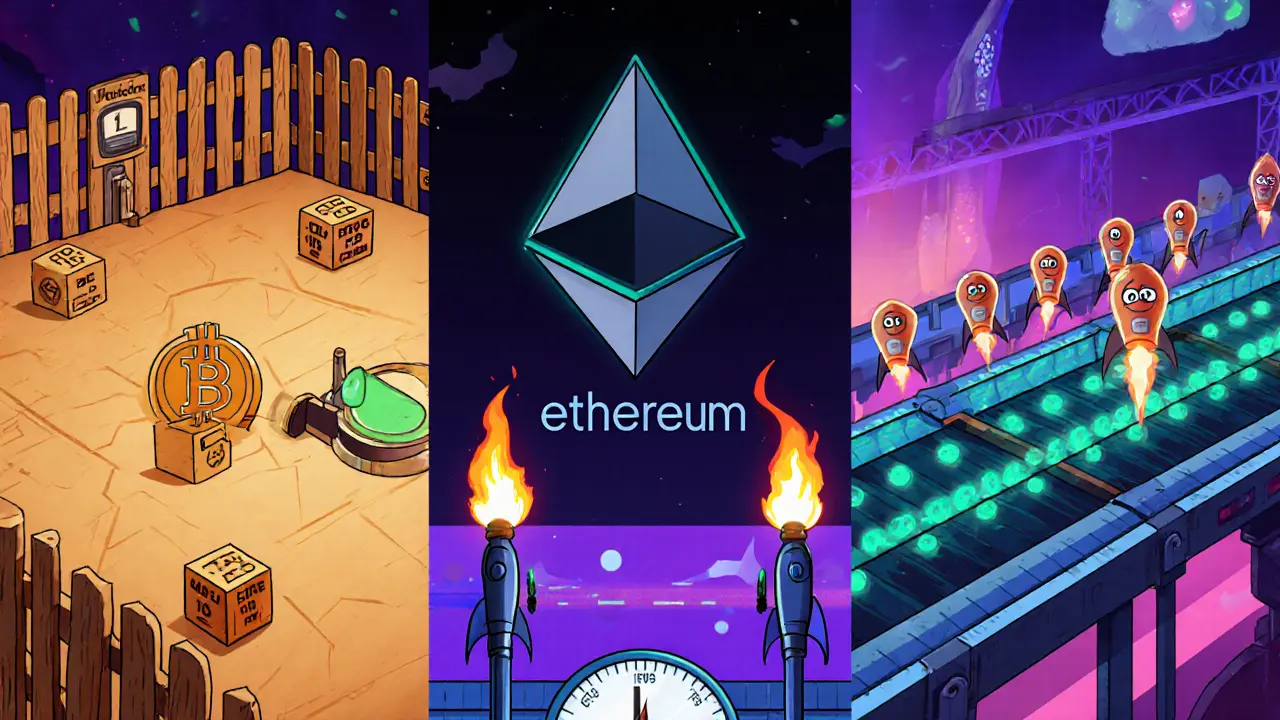 Sep, 10 2025
Sep, 10 2025
Mempool Fee Estimator
Estimate Your Transaction Fee
Calculate the optimal fee for your transaction based on current mempool conditions across major blockchains.
When a transaction leaves your wallet, it doesn’t jump straight onto the chain - it hangs out in a waiting room called the mempool management system. This temporary pool decides how fast your payment lands in the next block, how much you pay, and whether the network stays secure. With transaction volumes soaring and new Layer‑1s pushing performance limits, the way we handle mempools is about to change dramatically.
What a Mempool Is and Why It Matters
Mempool is a volatile memory buffer on each blockchain node that stores unconfirmed transactions until miners or validators include them in a block. It acts like a restaurant’s waiting area: transactions arrive, wait, and get seated based on the host’s (miner’s) preference. The size, eviction rules, and prioritization logic of a mempool directly affect fee markets, confirmation times, and overall network health.
Current Landscape: How Major Chains Manage Their Mempools
Three ecosystems dominate today’s conversation:
- Bitcoin runs a First‑Seen‑First‑Served (FSFS) model with a default 300MB RAM limit. Replace‑By‑Fee (RBF) lets users bump fees, but low‑fee spam can still clog the pool.
- Ethereum uses the txpool, ordering by gas price and account nonce. The London hard fork introduced EIP‑1559, burning base fees and reducing volatility, yet front‑running remains a risk.
- Solana employs a “turbocharged” batch mempool that can handle >65,000tps, but its reliance on rapid consensus has caused occasional outages.
Each design reflects trade‑offs between simplicity, fairness, and scalability.
Key Pain Points Today
Users and developers repeatedly hit the same problems:
- Fee spikes during peak demand - e.g., Ethereum gas surged to 1,500gwei during NFT drops in 2021.
- Stuck transactions that linger for hours when mempools fill beyond capacity.
- Vulnerability to mempool‑flood attacks that flood the buffer with low‑fee junk, inflating costs.
- Lack of cross‑chain visibility, forcing developers to write custom adapters for each network.

Emerging Solutions Shaping the Future
Several initiatives aim to make mempool handling smarter, faster, and more secure.
- Proposer‑Builder Separation (PBS) - slated for Ethereum’s Prague hard fork, PBS delegates block construction to specialized builders. This reduces MEV (Maximal Extractable Value) and lets dedicated mempool services optimise ordering.
- Avalanche’s Mempool2.0 - a standardized, cross‑subnet queue that promises uniform fee estimation across its ecosystem.
- Lightning Network’s mempool‑driven routing - uses real‑time pool data to find the least‑congested payment paths, cutting failed payments by roughly 38% in recent testnets.
- Blocknative’s Mempool API - offers 99.95% uptime real‑time monitoring, powering dynamic fee prediction tools used by exchanges like Coinbase.
- Flashbots’ builder ecosystem - provides transparent, auction‑based block building that can lower MEV extraction by up to $140million annually.
Side‑by‑Side Comparison of Leading Mempool Approaches
| Chain | Queue Model | Key Feature | Typical Size (RAM) | Notable Challenge |
|---|---|---|---|---|
| Bitcoin | First‑Seen‑First‑Served + RBF | Package RBF (draft BIP‑232) | 300MB (default) | Fee volatility during spikes |
| Ethereum | Gas‑price + nonce ordering | EIP‑1559 base‑fee burn | Variable, ~500MB+ | Front‑running / MEV |
| Solana | Batch‑processing turbo pool | High‑throughput parallelism | 2GB+ | Outage risk under overload |
| Cardano | Pruned pool (2‑hour expiry) | Ouroboros consensus | 200MB | Low‑priority tx delays |
| Avalanche | Standardized subnet pool | Mempool2.0 rollout | 300MB | Inter‑subnet coordination |
Market Outlook and Regulation
The transaction‑acceleration market linked to mempool tools is projected to hit $893million by 2028, growing at a 47% CAGR. Institutional players-68 of the Fortune 100-already run full nodes, but 42% flag mempool congestion as a blocker for DeFi adoption. Regulators are catching up; the SEC’s 2023 framework cites mempool dynamics when defining “finality” for securities settlements. Standard‑setting bodies like the W3C Blockchain Community Group are drafting cross‑chain mempool protocols, aiming for a 62% reduction in failure rates once adopted.

Practical Steps for Developers and Operators
If you’re building or maintaining a node, consider these actions:
- Tune
mempool.size(Bitcoin) ortxpool.memlimit(Ethereum) based on available RAM and expected traffic. - Enable Replace‑By‑Fee and monitor
mempool.expiryto prevent stale transactions from hogging space. - Integrate a real‑time mempool API (e.g., Blocknative) to offer users dynamic fee suggestions.
- Adopt mempool gating filters that reject sub‑minimum‑fee txs before they enter the pool.
- Test your node’s response to simulated flood attacks using tools like
tx-floodfrom the Bitcoin Knots suite.
For cross‑chain dApps, leverage the W3C‑proposed interoperability schema to publish your mempool status in a standard JSON‑LD format, making it easier for wallets and explorers to aggregate data.
Looking Ahead: What to Expect by 2030
Analysts at ARKInvest forecast a $2.3billion market for advanced mempool services by 2030. Expect three megatrends:
- Standardization: Unified mempool protocols will let validators exchange transaction snapshots, reducing duplicate propagation overhead.
- AI‑driven fee prediction: Machine‑learning models trained on historic pool data will auto‑adjust fees with sub‑second latency.
- Decentralized mempool marketplaces: Builders will compete for ordering rights, creating transparent auction layers that cut traditional miner cartel power.
These changes promise faster, cheaper, and more trustworthy blockchain experiences for everyone-from retail traders to multinational banks.
Frequently Asked Questions
What is the biggest limitation of current mempool designs?
The main bottleneck is static sizing and fee‑first ordering, which cause congestion spikes and make fee prediction hard for users.
How does EIP‑1559 improve mempool dynamics on Ethereum?
EIP‑1559 separates the base fee (burned) from the tip, smoothing fee volatility and giving users clearer cost expectations.
Can I customize my node’s mempool size?
Yes. Bitcoin Core allows -maxmempool and -limitfreq flags; Ethereum’s Geth uses --txpool.memlimit. Adjust based on RAM and expected load.
What is Proposer‑Builder Separation and why does it matter?
PBS splits block proposal (handled by validators) from block building (handled by specialized builders). This creates a market for optimal transaction ordering and cuts MEV extraction.
Are there cross‑chain tools that unify mempool monitoring?
Platforms like Tenderly and the emerging W3C mempool interoperability standard aim to expose a single API for multiple chains, simplifying developer workflows.
Bobby Lind
September 10, 2025 AT 17:53Wow, the mempool landscape is evolving faster than a coffee queue on a Monday morning!!! The blend of PBS, Avalanche’s Mempool2.0, and Blocknative APIs is like adding turbochargers to an already roaring engine, and I’m here for it!!! Keep an eye on the fee prediction models, they’re about to become as reliable as your favorite weather app!!! 🚀🚀🚀
lida norman
September 11, 2025 AT 16:13Reading this feels like watching a blockbuster movie where every scene is a cliff‑hanger! 😱 The way Blocknative’s API gives near‑real‑time visibility is pure drama! And the Lightning‑driven routing? That’s a hero’s journey right there, cutting failed payments by a whopping 38% – it’s like giving the underdog a secret weapon! 🎬✨
Miguel Terán
September 12, 2025 AT 15:50The mempool is essentially a waiting room for transactions that can dictate the health of a blockchain network. Historically each node kept a volatile buffer that stored unconfirmed data until a miner or validator decided to include it in a block. This simple design works well for low‑volume chains but begins to crack under the pressure of modern DeFi activity. As transaction volumes soar the static size limits become a bottleneck that forces users to overpay or wait for hours. Emerging solutions such as Proposer‑Builder Separation aim to offload ordering decisions to specialized builders which can dynamically prioritize based on market signals. Avalanche’s Mempool2.0 proposes a standardized cross‑subnet queue that could harmonize fee estimation across disparate chains. Lightning Network routing now uses real‑time mempool data to sidestep congested paths and improve payment success rates. Blocknative’s API provides near‑perfect uptime allowing developers to feed live data into fee prediction algorithms. Flashbots builders create transparent auction markets that could reduce MEV extraction dramatically. The combination of these technologies suggests a future where fee volatility is smoothed by algorithmic intelligence rather than user guesswork. AI‑driven models trained on historic pool patterns may soon auto‑adjust fees within milliseconds. Decentralized mempool marketplaces might let multiple builders compete for ordering rights, introducing competition that could democratize transaction placement. Standardized protocols could enable validators to exchange transaction snapshots, cutting duplicate propagation overhead. By 2030 we may see a unified mempool ecosystem that supports cross‑chain visibility and rapid scaling. All of these trends point toward a more efficient, cost‑effective blockchain experience for both retail users and institutional players.
Shivani Chauhan
September 13, 2025 AT 15:26I appreciate the depth of the analysis and would add that tuning mempool parameters is a practical first step for node operators. For Bitcoin adjusting -maxmempool can prevent overflow during spikes, while for Ethereum the --txpool.memlimit flag allows you to balance RAM usage against throughput. Monitoring the eviction policy helps avoid stale transactions lingering and consuming resources. Implementing a minimum fee filter before entry can further reduce spam. Additionally, logging fee distribution trends gives insight into market dynamics and can guide dynamic fee suggestions. These actions collectively improve stability without requiring wholesale protocol changes.
Deborah de Beurs
September 14, 2025 AT 15:03Hold on, you’re painting a rosy picture but ignoring that most of these “solutions” are still experimental and could introduce new attack vectors! The idea that AI will magically fix fee spikes is nonsense until proven in hostile environments – it’s a marketing gimmick, not a security guarantee! Moreover, relying on proprietary builders risks centralizing power again, which defeats the whole decentralization ethos! Don’t be so gullible.
Sara Stewart
September 15, 2025 AT 14:40Great points! From a developer’s perspective, integrating Blocknative’s Mempool API into your stack can enable dynamic gas oracle feeds, which dramatically reduces over‑paying during congestion. You’ll also want to leverage the mempool gating filters that pre‑validate minimum tip thresholds, effectively throttling low‑ball spam. Pair these with real‑time telemetry dashboards to visualize pool depth and fee distribution across epochs. This stack‑up equips you with a resilient architecture ready for the next wave of DeFi traffic.
Pierce O'Donnell
September 16, 2025 AT 14:16Sounds overhyped to me.
Vinoth Raja
September 17, 2025 AT 13:53Interesting take, though one could argue that adding more layers of abstraction merely shifts the bottleneck rather than eliminating it. In philosophy we say that the map is not the territory, and here the API is the map while the underlying consensus still decides finality. So while the tools are slick, the fundamental limits remain rooted in network economics.
DeAnna Brown
September 18, 2025 AT 13:30Listen up, everyone – the future of mempool management is already written in the code of tomorrow’s blockchains, and you’re just catching up! The only way to truly dominate is to adopt decentralized ordering markets now, before the rest of the industry even realizes what they’re missing! This isn’t a suggestion, it’s a call to arms for anyone who wants to stay relevant in the crypto arena! 🇺🇸
Chris Morano
September 19, 2025 AT 13:06I hear your enthusiasm and appreciate the passion behind it. While competition can indeed spur innovation, fostering collaborative standards may lead to broader adoption and interoperability sooner. Encouraging open dialogue between builders and validators can strike a balance between market dynamics and network health. Let’s keep the conversation constructive and focus on solutions that benefit the whole ecosystem.
Ikenna Okonkwo
September 20, 2025 AT 12:43The exchange of ideas we’re seeing now reminds me of early internet forums where diverse viewpoints eventually converged into robust protocols. If we maintain this collaborative spirit, the mempool landscape will likely evolve into a standardized, AI‑enhanced system that serves both users and validators alike. Optimism paired with careful engineering can turn today’s challenges into tomorrow’s opportunities.
Katharine Sipio
September 21, 2025 AT 12:20In conclusion, the advancements discussed provide a clear path forward for improving transaction throughput and fee predictability. By adopting the recommended best practices, developers and operators can enhance network performance while maintaining security. I encourage all participants to continue exploring these technologies and to share their findings with the community.